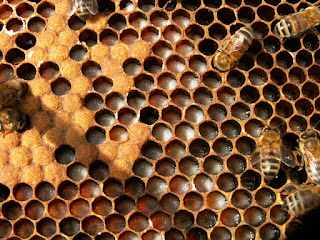I was quite taken aback by the intensity of the yellow of the pollen stores we found in our hives today - and the quantity, particularly in one of the hives. Unfortunately our efforts to encourage the bees to create new brood comb, via the Bailey Change process, failed. In one of the hives the bees did not move at all into the new brood box we provided - and in the other hive, the bees had moved into the new brood box and started making new brood comb although we did not find the queen to ensure she/it had actually moved up into the new box. We decided to put the freshly drawn brood comb into the old box where we were sure the queen still resided. That was a week ago. Since then both hives/colonies have 'come on' encouragingly; with plenty of new brood - baby worker bees - and the vivid yellow of the pollen stores - sometimes known as 'bee-bread'. Both the colonies had made a lot of progress in creating new capped honey stores in the super above each brood box; so much so we added a new super to each hive.
All being well, the abundance of pollen will enable the colonies (their nurse bees) to provide the body building proteins/nutrients (Vg) to the larvae and so help establish healthy and vigorous populations. Today we also removed a brood frame from each brood box and substituted with a shallower 'super' frame; the purpose being to encourage the bees to produce the drone brood comb all most exclusively from the bottom edges of those shallower frames so that we might more easily remove the drone brood. The varroa mite incubates more in the drone brood cells and so that pest can be managed more effectively by using a super frame in the brood box.
We think much of the pollen was foraged from a nearby willow - about 30 metres from the apiary. This year the willow in the picnic area is resplendent in all its blossom and there was a great variety of insect foragers coming and going about it. I forgot to look at the willow dome at the bottom edge of the forest garden. It may also be in bloom and as it is closer to the apiary it could be a more convenient (they are urban edge bees), less energy consuming, source of nutrition. A measure of the intensity of the colour of the pollen and the abundance is shown in the image of the fingers which have just lightly touched the pollen flowers.
Willow - Salix, is recognised as a good source of early spring nectar and pollen. Alison Benjamin, co-author of, Bees in the City (with Brian McCullum) asserts it is important to increase the amount and diversity of forage for honey bees and other pollinators. They list, S. apoda, S. boydii and S. lanata along with a few others as being especially good sources of pollen and nectar. I don't know what variety of willow we have here.
It is not Salix babylonica - the weeping willow, under which recently I sat with the ituned spirit of a jilted Woody Guthrie as he sang, Bury Me Beneath the Willow - of which, many renditions can be found on Youtube. I quite like the Woody Guthrie Folk Club (of Liverpool) version. We chewed on the cuddy bark of Salix alba and felt a little better for it, our aching hearts and minds soothed. It's amazing what aches and pains an aspirin like derivative can ease. When Woody had finished lamenting we imbibed the fluid descending notes and rapid sonorous flourishes of a willow warbler .
As Field Study's Man in E17, I mentally drifted (if not derived), along to the warbles, into some reflections on my connections with a certain Mr Patrick Keiller and his forthcoming emanation via The Robinson Institute (in situ) at the Duveen Gallery, Tate Britain - 27th March to 14th October. I recalled the poster for this exhibition - an image of rusted yellow lichen against a hexagonal honey comb like pattern which turns out to be, if you watch Robinson in Ruins, the nitrogen saturated or polluted site of an A road signpost. You might find the image here or drift about London's saucy district, Soho where earlier in the week, the lichen appeared to be growing in abundance in the radiance of neon.















No comments:
Post a Comment